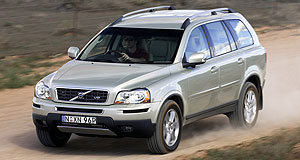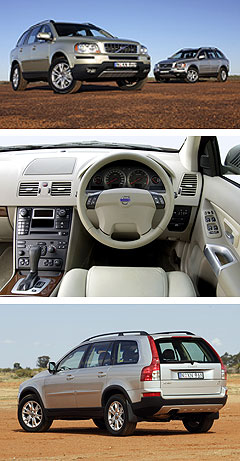First drive: Volvo XC90 offers broader options
BY TIM BRITTEN | 19th Sep 2006

Sales of the former have been climbing steadily since it was launched here in July 2003, and year-to-date figures for 2006 show an almost 30 per cent increase over 2005.
Globally, the XC90 is working so well for Volvo that production from Volvo’s Torslanda plant in Sweden has risen from 50,000 XC90s a year in 2003 to 90,000 today.
In fact, the XC90 and XC70 would almost define Volvo as an SUV company were it not for the parallel success of its Ford Focus/Mazda3-shared S40 sedan and V50 wagon. The profile of Volvo is somewhat different today to what it was before the advent of its SUVs and shared-platform small car.
The XC90 gets a big kick this week with the launch of its 2007 update that includes not just a new five-cylinder turbo-diesel but also a new 4.4-litre V8 developed in collaboration with Yamaha.
The first-ever Volvo V8, the big petrol engine heralds the departure of the six-cylinder turbo T6 model and a readjusted range that now also includes a new D5 turbo-diesel (expected to be the top seller and also due to go into the S80 flagship) while continuing with the 154kW T5 turbo five-cylinder.
The all-alloy DOHC 32-valve 60-degree transverse V8, with variable camshaft timing on both inlet and exhaust camshafts, looks to be something special and is claimed to be the most compact on the market. It appears behind its first Volvo badge in the XC90 and is expected to follow in the luxury S80 model later on.
The short-stroke V8 cylinder arrangement places each piston at the mid-way point between those on the opposing cylinder bank, resulting in a tightly packed arrangement measuring just 754mm long and 635mm wide. The new V8 is light, too, tipping the scales at 190kg and, with a counter-rotating balance shaft, is also smooth.
With four catalytic converters it is also claimed to be the cleanest petrol V8 on the market today and meets the American ULEV II (Ultra Low Emission Vehicle, stage II) requirements as well as forthcoming Euro 5 standards.
It churns out the power, too, developing 232kW at 5850rpm and an efficient 440Nm of torque, which is even better than it sounds because even though the maximum does not come in until 3900rpm, there is already 370Nm available by 2000rpm.
Standard transmission in the XC90 V8 is Volvo’s brand-new six-speed auto which picks up the Geartronic tag, meaning it is a sequential-changer. Sixth gear is purely an economy-friendly overdrive, while torque converter lock-up is active on all gears.
The XC90’s all-wheel drive system is an upgraded version of the on-demand Haldex arrangement featured on the outgoing version that sends power more quickly to the rear wheels if needed.

While the XC90 T5 version continues with the five-speed auto transmission, the six-speed transmission introduced on the V8 is also standard on the new five-cylinder turbo-diesel D5.
A development of the all-aluminium inline five-cylinder T5 petrol engine, the DOHC 20-valve turbo-diesel eschews the increasingly more common direct injection and was launched on other world markets in 2005 where it is available in three forms with varying outputs.
We get the maxi-power version producing 136kW and 400Nm with the help of a variable-vane turbocharger, larger, lower-compression combustion chambers and a seven-nozzle port-injection system.
The turbo-diesel also gets a standard particulate filter to minimise the unburned small particles that are the bane of many early diesel engines. The filter is maintenance free and burns away the diesel soot in a 20-minute cycle at 500km to 1000km intervals depending on the build-up. Volvo says the filtration efficiency is more than 95 per cent.
Claimed average fuel consumption average for the turbo-diesel is 9.0L/100km, while it will reach 100km/h from a standing start in a leisurely 11.5 seconds. The XC90’s weight at 2069kg is slightly lighter than the V8 and conspires against it here.
The T5 turbo is quicker than the diesel, reaching 100km/h in a claimed 9.9 seconds, but can only offer an average fuel consumption figure of 12.0L/100km.
All XC90s come with Volvo’s roll stability control system (RSC), traction control and ABS with EBD and brake assist.
The $84,950 V8 is fitted with 18x7-inch alloy wheels wearing 235/60R18 tyres, while the T5 and D5 are equipped with 17x7 alloys and 235/65R17 tyres. The XC90 continues with a space-saver spare wheel, while both petrol versions have an 80-litre fuel tank, and the D5 a smaller 68-litre tank.
Dual front and side airbags, full-length curtain airbags, active front-seat head restraints, leather trim, climate-control dual-zone air-conditioning, power driver’s seat with memory, cruise control, trip computer and rear parking sensors are standard across the range.
The V8 model has power to the front passenger seat as well, as well as adding heating for both front seats, a six-disc in-dash CD stacker, rain sensor wipers and laminated side windows.
Volvo is still promoting the in-car sound quality of the XC90, providing a 4x40W eight-speaker sound system in T5 and D5, and a Bose premium sound system with a 5x130W amplifier, 12 premium speakers and a six-disc in-dash CD changer, in the V8.
Optional equipment includes a sunroof, satellite navigation, bi-Xenon lights (available for even more with active control), metallic paint, softer leather and blind-spot warning (BLIS) which uses digital cameras mounted on the side mirrors to detect and inform the driver via a yellow warning light if a vehicle is travelling in the car's blind spot.
| 2006 Volvo XC90 pricing: | |
| LE (a) | $69,950 |
| D5 (a) | $72,950 |
| V8 (a) | $84,950 |